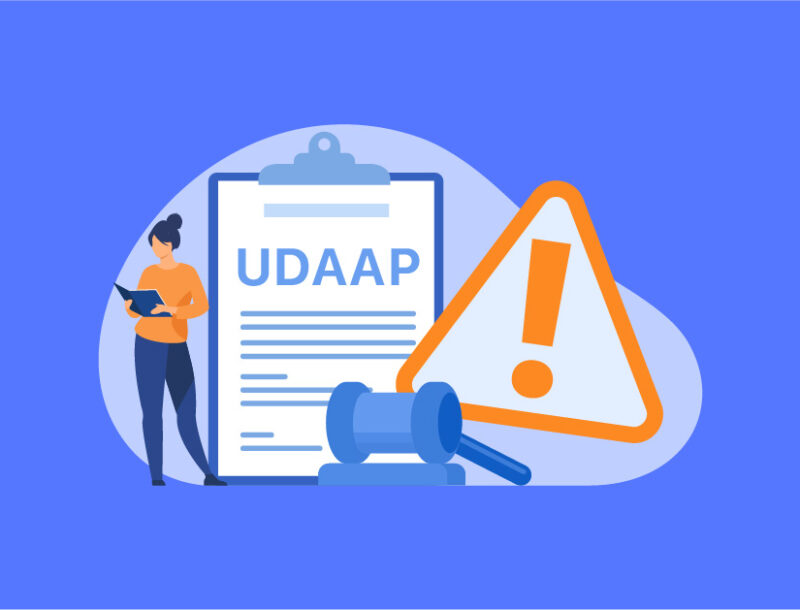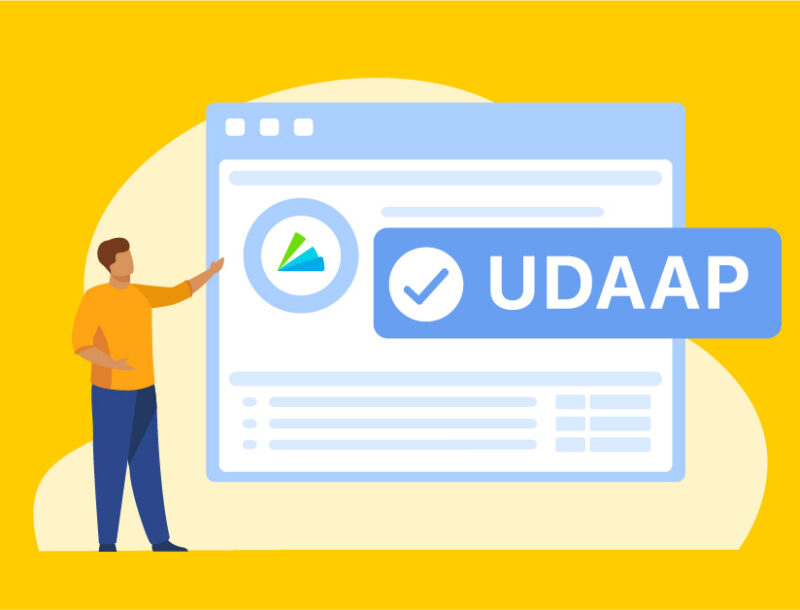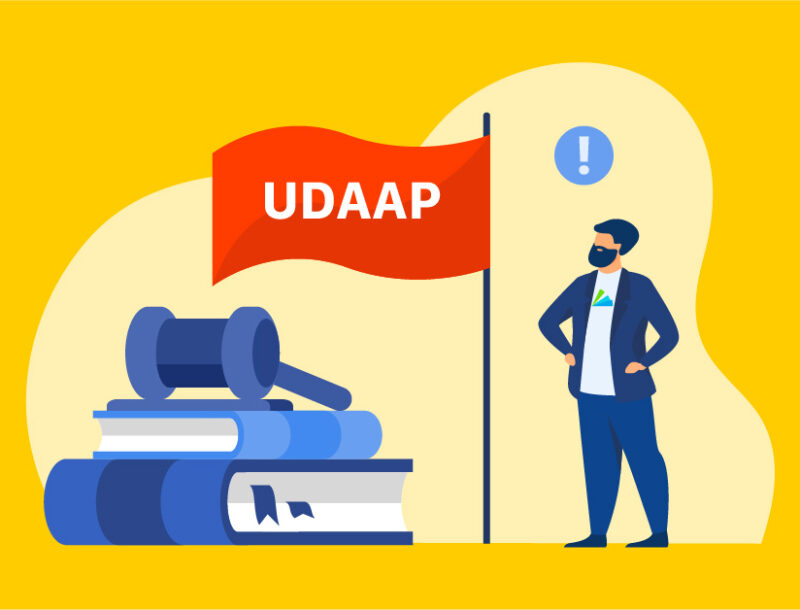Best Practices for UDAAP Compliance [GUIDE]
![Best Practices for UDAAP Compliance [GUIDE]](https://performline.com/wp-content/uploads/2023/01/blog-featuredimage-best-practices-udaap-guide.png)
After the 2008 financial crisis, regulators put new laws in place to protect consumers and help them regain confidence in Financial Institutions. According to the Dodd-Frank Wall Street Reform and Consumer Protection Act created in 2010, UDAAPs (unfair, deceptive, or abusive acts and practices) by those who offer financial products and services to customers are illegal. In turn, regulators like the CFPB (Consumer Financial Protection Bureau) and the FTC (Federal Trade Commission) are keeping an eye on financial institutions, fintechs, gig economy players and more, forcing them to protect current customers and other consumers against UDAAPs by monitoring their sales and marketing efforts. Understanding and complying with the complete UDAAP policy can be a challenge, but failing to do so can lead to costly penalties and damaged reputations.
What is UDAAP?
In simplest terms, UDAAPs are unfair, deceptive, and abusive acts or practices by financial institutions or any other organization that offers financial products or services to consumers. Under Dodd-Frank, UDAAPs are illegal and non-compliance can lead to serious consequences. Its purpose is to ensure that consumers have access to the information they need in order to choose the best product or service for their individual situations and needs.
Defining UDAAP Can Be Difficult
For compliance leaders, UDAAP can be difficult to identify and comply with because of its very broad definition. At times, it can also be difficult to understand because of overlap with other consumer protection laws and regulations. Adding even more complexity, there are many ways in which these rules can be interpreted, and previous regulatory standards aren’t always consistent.
How UDAAP Enforcement Has Evolved Since 2019
In recent years, the CFPB has expanded its interpretation of UDAAP, focusing on digital financial services and so-called “junk fees”, hidden or excessive charges that harm consumers. Fintech and BNPL providers, along with traditional financial institutions, are now facing heightened expectations for transparency in marketing, disclosures, and digital user experience.
To help break this down, here’s a more in-depth look at each part of UDAAP according to Dodd Frank:
Unfair
An “unfair” practice is one that a consumer cannot avoid, that would put them in financial harm and where the benefits to the consumer don’t outweigh the injury sustained. Examples include lenders keeping liens on paid-off homes, car dealerships not disclosing fees in advertising or banks keeping connections with someone who’s committed fraud.
Deceptive
A “deceptive” practice is one that misleads or has the intention to mislead. The intent does not come into play with these determinations, and often actual deception doesn’t need to occur as long as there can be an interpretation of deception.
Abusive
Acts and practices deemed “abusive” are essentially ones that don’t fall into unfair or deceptive but are still disliked by regulators. The definition of what is considered abusive is lengthier than the others because it was created to be broad and catch what would otherwise slip through the cracks. Since it’s the most difficult to define, there have been inconsistent applications of it. A few guidelines to follow when determining if something is abusive are:
- Interferes with the consumer’s ability to understand the terms or conditions of a product or service
- Takes advantage of a consumer’s lack of understanding of risks, costs or conditions
- There is an inability to protect their own interests when selecting and/or using a product or service
- If there is a reliance on a covered person to act in their interests

UDAAP Risks in Digital Marketing & AI
As financial institutions rely more on digital marketing and AI-driven tools, they must ensure algorithms and targeting mechanisms do not inadvertently mislead or discriminate. For example:
- Biased credit approval algorithms can result in disparate impact, triggering UDAAP scrutiny.
- Dynamic ad content can unintentionally misrepresent product features or rates.
- Chatbots and automated disclosures must still meet clarity and accuracy standards.
Given the pace of regulatory change and the volume of digital content produced by financial institutions, manual review processes often fall short. That’s where automated compliance monitoring platforms like PerformLine provide value, continuously scanning marketing, sales, and web materials across channels to detect potential UDAAP risks before they become violations.
Protecting Your Company by Avoiding UDAAP Violations
Compliance professionals are tasked with the burdensome responsibility of protecting their organizations and their customers by complying with consumer protection laws. With all of this complexity, ensuring that your organization is complying with UDAAP can be a bit tricky.
Here are 8 steps your company can take right now to help avoid UDAAP compliance violations.
8 Steps to Reduce UDAAP Compliance Violations
- Learn: Understand what counts as unfair, deceptive, or abusive, and stay current as regulations evolve.
- PerformLine helps identify patterns that may indicate potential UDAAP risks early.
- Review Often: Regularly audit marketing, digital, and partner communications.
- PerformLine automates reviews across web, social, and email channels to flag risky content.
- Track Complaints: Monitor consumer feedback to catch recurring issues.
- PerformLine links complaint insights with real communications for faster root-cause detection.
- Act Quickly: Investigate and resolve potential violations immediately.
- PerformLine workflows route flagged content for review and remediation in real time.
- Reach Out: Collaborate with internal teams and compliance experts.
- PerformLine’s shared dashboards align compliance and marketing for faster decisions.
- Rinse and Don’t Repeat: Fix systemic issues to prevent repeat violations.
- PerformLine analytics track risk trends and demonstrate progress to regulators.
- Tell and Do: Communicate clearly, deliver consistently, and honor promises to consumers.
- PerformLine ensures messages stay compliant and aligned with what’s offered.
- Protect Your Brand: View compliance as a trust and reputation strategy.
- PerformLine’s automated monitoring protects brand integrity before issues escalate.
If you need more help avoiding UDAAP and other common compliance violations or have more questions, our experts are ready to help.
FAQs
UDAAP stands for Unfair, Deceptive, or Abusive Acts or Practices. It prohibits financial institutions and service providers from misleading or taking advantage of consumers.
Common violations include hidden fees, misleading advertising, complex loan terms, or practices that confuse or exploit consumers. Even unintended misrepresentations can trigger UDAAP scrutiny
The Consumer Financial Protection Bureau (CFPB) and Federal Trade Commission (FTC) enforce UDAAP, often in coordination with state regulators.
Avoiding violations requires clear disclosures, transparent marketing, complaint monitoring, employee training, and proactive audits of all customer-facing communications.
UDAAP applies broadly across banks, fintechs, lenders, credit card issuers, mortgage providers, and buy-now-pay-later companies.
AI systems used in marketing or lending can unintentionally mislead or discriminate. Compliance teams should regularly audit algorithms, data inputs, and outputs for bias and accuracy.
Automation tools like PerformLine help organizations monitor digital channels, flag high-risk content, and ensure marketing aligns with regulatory standards in real time.
Updated: Dec 13, 2025


